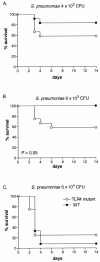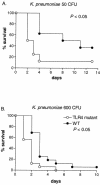Role of Toll-like receptor 4 in gram-positive and gram-negative pneumonia in mice
- PMID: 14742522
- PMCID: PMC321591
- DOI: 10.1128/IAI.72.2.788-794.2004
Role of Toll-like receptor 4 in gram-positive and gram-negative pneumonia in mice
Abstract
To determine the role of Toll-like receptor 4 (TLR4) in the immune response to pneumonia, C3H/HeJ mice (which display a mutant nonfunctional TLR4) and C3H/HeN wild-type mice were intranasally infected with either Streptococcus pneumoniae (a common gram-positive respiratory pathogen) or Klebsiella pneumoniae (a common gram-negative respiratory pathogen). In cases of pneumococcal pneumonia, TLR4 mutant mice showed a reduced survival only after infection with low-level bacterial doses, which was associated with a higher bacterial burden in their lungs 48 h postinfection. In Klebsiella pneumonia, TLR4 mutant mice demonstrated a shortened survival after infection with either a low- or a high-level bacterial dose together with an enhanced bacterial outgrowth in their lungs. These data suggest that TLR4 contributes to a protective immune response in both pneumococcal and Klebsiella pneumonia and that its role is more important in respiratory tract infection caused by the latter (gram-negative) pathogen.
Figures




References
-
- Bartlett, J. G., and L. M. Mundy. 1995. Community-acquired pneumonia. N. Engl. J. Med. 333:1618-1624. - PubMed
-
- Barton, G. M., and R. Medzhitov. 2002. Toll-like receptors and their ligands. Curr. Top. Microbiol. Immunol. 270:81-92. - PubMed
-
- Benton, K. A., J. C. Paton, and D. E. Briles. 1997. The hemolytic and complement-activating properties of pneumolysin do not contribute individually to virulence in a pneumococcal bacteremia model. Microb. Pathog. 23:201-209. - PubMed
-
- Bernheiden, M., J. M. Heinrich, G. Minigo, C. Schutt, F. Stelter, M. Freeman, D. Golenbock, and R. S. Jack. 2001. LBP, CD14, TLR4 and the murine innate immune response to a peritoneal Salmonella infection. J. Endotoxin Res. 7:447-450. - PubMed
-
- Beutler, B., and E. T. Rietschel. 2003. Innate immune sensing and its roots: the story of endotoxin. Nat. Rev. Immunol. 3:169-176. - PubMed
MeSH terms
Substances
LinkOut - more resources
Full Text Sources
Other Literature Sources
Medical
Molecular Biology Databases

